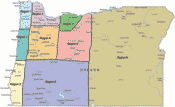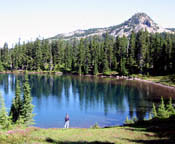| home |
| communities |
| regions |
| activities |
| culture |
| education |
| facts about Oregon |
| geography |
| internet links |
| maps |
| about us |
| advertising |
| contact |
| Culture |
History and Economy |
Approximately 80 native American tribes inhabited Oregon before the establishment of pioneer settlements. In 1792, Captain Robert Gray came up the mouth of the Columbia River and staked the American claim to the Oregon territory. The Lewis and Clark expedition (1804-07), which culminated at the mouth of the Columbia River, further reinforced American claims to Oregon. Trappers and traders were the harbingers of the coming migration of Europeans. Between 1840 and 1850, over 53,000 people traveled the Oregon Trail. Native American exposure to diseases such as smallpox and diphtheria decimated the tribes, and that, along with the encroachment of settlers on tribal lands, was the cause of much strife between native Americans and the incoming Europeans. The Land Donation Law, a government land giveaway allotting 320 acres to white male pioneers and 640 acres to married white couples, gave impetus to the western expansion and the American idea of "manifest destiny". This promotion of migration and families also allowed America to strengthen its hold on Oregon, in the interests of displacing British claims. Oregon was admitted as a state on Valentine's Day, 1859, as a non slavery state. While economic development was slow in the coastal region, the Willamette Valley and Portland in particular, was booming. Fueled in part by gold discoveries in Baker and Grant Counties in 1861 and '62, Portland was well on its way to becoming a major shipping port, especially in wheat. In the 1880s, the coming of the railroads connecting Portland with San Francisco and the transcontinental railroad further fueled economic development. Portland became the economic center of the state. The first World War stimulated the shipyards and timber trades in Oregon, especially Portland. In the 1930s, New Deal programs such as the Works Projects Administration and the Civilian Conservation Corps built many projects around the state, including such Oregon treasures as Timberline Lodge on Mt. Hood. Hydroelectric dams and roads were also built at this time, improving the quality of life of many Oregonians. This encouraged settlement, and irrigation water from the Columbia River aided agricultural development. The Bonneville Dam was a plentiful and cheap source of power, which stimulated the development of industries such as aluminum plants during World War II. Food production, shipbuilding and the lumber were also greatly enhanced by the needs of the nation during WWII. Oregon's economy still depends greatly on agriculture. In recent years, electronics and tourism have broadened its economic base. Tourism is now the state's third largest source of revenue, after lumber and agriculture. In agriculture, Oregon is one of the top producers in such crops as greenhouse and nursery products, Christmas trees, grass seed, peppermint, blackberries and filberts. Other crops produced in Oregon are wheat, potatoes, pears, onions, snap beans and sweet corn. The products of Oregon wineries are nationally known, especially the chardonnay and pinot noir from Yamhill and Washington counties. The diversity of berries produced here (strawberries, blueberries, raspberries and many other varieties of cane berries) make spring an eagerly awaited season in Oregon. GovernmentOregon has three branches of government - Executive, Legislative and Judicial. The Executive branch is composed of six statewide elected officials that administer and manage state agencies. The officials are the Governor, Secretary of State, Treasurer, Attorney General, Commissioner of Labor and Industries, and Superintendent of Public Instruction. The Governor is responsible for submitting a budget to the Legislature covering all state agencies every two years. The Legislature's main functions are to finance state government, enact laws and provide an area for discussion of public issues. Since the first session in 1860, the Legislature has provided these services. It also reviews and revises (if necessary), the proposed budget and passes tax laws to provide revenue. The laws enacted by the Legislature establish state policies that, along with the adopted budget, direct all state agency activity. The Judicial branch's function is to interpret the actions of the Legislature and state agencies as they relate to the Oregon Constitution. They also deliberate on civil, criminal and governance issues. |
| OREGON DESTINATIONS | ||
|
||



